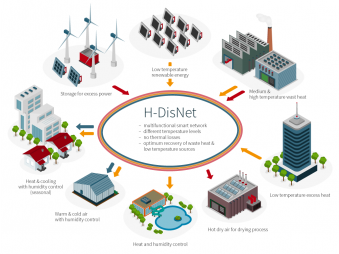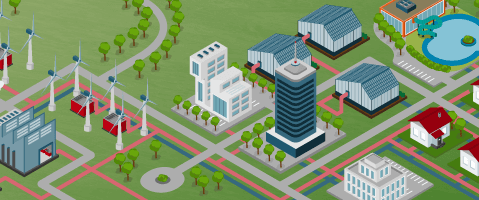PROJECT H-DisNet
Intelligent Hybrid Thermo-Chemical District Networks
“Heating and cooling consumes half of the EU’s energy. Developing a strategy to make heating and cooling more efficient and sustainable is a priority for the Energy Union […]. Heating and cooling and electricity systems can support each other in the effort to decarbonise. It is essential to recognise the links between them and exploit synergies” [An EU Strategy on Heating and Cooling, 16.02.2016].
Conventional district heating and cooling systems combine these synergies by distributing heat generated from a centralized location including residual heat to remote users. However they need to be more efficient, intelligent and cheaper integrating multiple efficient generation sources, bringing down heat distribution losses and integrating storage systems.
H-DisNet: INTELLIGENT HYBRID THERMO-CHEMICAL DISTRICT NETWORK
The H-DisNet project contributes to next-generation of district energy networks developing the innovative thermo-chemical (TC) network technology. The technology exploits the high chemical potential of absorption processes for loss-free transport and storage of energy potential.
The technology will be applied to form an intelligent district network with thermal, electric and gas networks.

Loss-free energy network
This intelligent thermo-chemical district network will have a strong impact on the future energy systems and will significantly
- increase energy efficiency of heat transport and storage
- increase utilization of residual heat and heat using renewable sources at low temperature
- contribute to a wider usage of district networks by enabling heating and cooling in one multifunctional network and by including the additional services drying and humidity control
- reduce the primary energy usage by forming energy cascades.
Project approach
The project will gain the required knowledge about processes, components, network applications as well as simulation and control methods and will demonstrate the feasibility to allow the industrial R&D to pick up the technology and to bring it to the market.
News
Aug 24, 2020 H-Disnet completed
The project H-Disnet was successfully completed. All the public deliverables are online.
Jan 9, 2020 Watt d'Or 2020
The Swiss demonstrator in the greenhouse received the Watt d'Or 2020 award in the Energy Technology category from the Swiss Federal Office of Energy.
Dec 2, 2019 H-DisNet Webinar
The presentation and videos of the webinar hold on 18th of November are online.
Oct 31, 2019 H-DisNet Webinar
Join the H-DisNet Webinar "Technology for next generation district heating networks" Monday, November 18, 2019, at 14:00
Oct 1, 2019 Paving the way to the market
Representatives from industry and the public sector provided new insights into the challenges and opportunities of the H-DisNet technology on its way to the market.
Show All News

